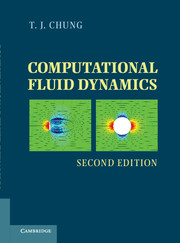Book contents
- Frontmatter
- Contents
- Preface to the First Edition
- Preface to the Revised Second Edition
- Part One Preliminaries
- Part Two Finite Difference Methods
- Part Three Finite Element Methods
- Chapter Eight Introduction to Finite Element Methods
- Chapter Nine Finite Element Interpolation Functions
- Chapter Ten Linear Problems
- Chapter Eleven Nonlinear Problems/Convection-Dominated Flows
- Chapter Twelve Incompressible Viscous Flows via Finite Element Methods
- Chapter Thirteen Compressible Flows via Finite Element Methods
- Chapter Fourteen Miscellaneous Weighted Residual Methods
- Chapter Fifteen Finite Volume Methods via Finite Element Methods
- Chapter Sixteen Relationships Between Finite Differences and Finite Elements and Other Methods
- Part Four Automatic Grid Generation, Adaptive Methods, and Computing Techniques
- Part Five Applications
- Appendixes
- Index
- References
Chapter Eight - Introduction to Finite Element Methods
from Part Three - Finite Element Methods
Published online by Cambridge University Press: 05 June 2012
- Frontmatter
- Contents
- Preface to the First Edition
- Preface to the Revised Second Edition
- Part One Preliminaries
- Part Two Finite Difference Methods
- Part Three Finite Element Methods
- Chapter Eight Introduction to Finite Element Methods
- Chapter Nine Finite Element Interpolation Functions
- Chapter Ten Linear Problems
- Chapter Eleven Nonlinear Problems/Convection-Dominated Flows
- Chapter Twelve Incompressible Viscous Flows via Finite Element Methods
- Chapter Thirteen Compressible Flows via Finite Element Methods
- Chapter Fourteen Miscellaneous Weighted Residual Methods
- Chapter Fifteen Finite Volume Methods via Finite Element Methods
- Chapter Sixteen Relationships Between Finite Differences and Finite Elements and Other Methods
- Part Four Automatic Grid Generation, Adaptive Methods, and Computing Techniques
- Part Five Applications
- Appendixes
- Index
- References
Summary
General
The finite element theory as applied to one-dimensional problems was discussed in Part One, Preliminaries. In general, finite element methods (FEM) are versatile in applications to multidimensional complex irregular geometries. Initial applications of FEM began with structural analysis in the late 1950s and primarily were based on variational principles. During the early days of the development of FEM, applications were made for simple flow problems, beginning with Zienkiewicz and Cheung [1965], followed by Oden and Wellford [1972], Chung [1978], and Baker [1983], among others. Significant contributions in CFD began with the streamline upwind Petrov-Galerkin (SUPG) methods [Heinrich, Huyakorn, Zienkiewicz, and Mitchell, 1977; Hughes and Brooks, 1982; Hughes, Mallet, and Mizukami, 1986] or streamline diffusion methods (SDM) [Johnson, 1987], Taylor-Galerkin methods (TGM) [Donea, 1984; Löhner, Morgan, and Zienkiewicz, 1985], and hp adaptive methods [Oden and Demkowicz, 1991], among many other related works.
New approaches and various alternative methodologies are preponderant in the literature. Efforts are made in this book to simplify and unify some of the terminologies. For example, the original approaches of SUPG or SDM for convection-dominated flows have grown into GLS (Galerkin/least squares) when some changes in the formulation are introduced. It is suggested that all methods related to numerical diffusion test functions be called the generalized Petrov-Galerkin (GPG) methods. Hughes and his co-workers have contributed significantly in the past two decades to the GPG methodologies associated with the problems of convection-dominated flows and shock discontinuities.
Information
- Type
- Chapter
- Information
- Computational Fluid Dynamics , pp. 243 - 261Publisher: Cambridge University PressPrint publication year: 2010
